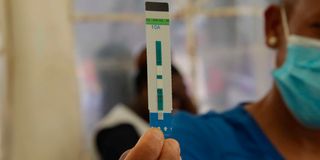Why Kenya is likely to face a HIV crisis

A health worker holds an HIV test strip during World Aids Day in Nanyuki town on December 1, 2022.
Nearly half of Kenyan teenagers aged 15 to 17 years do not know how to protect themselves from HIV/Aids infection, the Kenya Demographic and Health Survey (KDHS) 2022 shows.
This comes even after last year’s World Aids Day report showed that the country had recorded an increase in new HIV infections – from 32,025 to 34, 540 – for the first time in a decade.
Of the 34,540 new cases, 70 per cent occurred among women and girls while 52 per cent of all new infections occurred among adolescents and young adults aged 15 to 29 years.
But now, according to researchers from the Kenya National Bureau of Statistics (KNBS) who were investigating the level of knowledge in youths aged 17-24 on how HIV is transmitted, slightly more than half of young people in the country know about HIV prevention (54 per cent of women and 55 per cent of men).
“Knowledge of prevention is lowest among those aged 15 to 17 (44 per cent) and among those who have never had sex (47 per cent of women and 48 per cent of men). Young women and men in urban areas are more likely than their counterparts in rural areas to have knowledge about HIV prevention – 57 per cent of young women and 63 per cent of young men in urban areas have knowledge about prevention, compared to 52 per cent of young women and 51 per cent of young men in rural areas,” KNBS states.
The researchers further pointed out that knowledge about HIV prevention increased with education, from 13 per cent among young women with no education to 69 per cent among those with more than a secondary education, and from 14 per cent among young men with no education to 80 per cent among those with more than a secondary education.
In 2019, a peer reviewed study by the Africa Population Health Research Centre found that young people in Kenyan schools are misinformed about sex and sexuality, with nearly one in four secondary school students in Homa Bay, Mombasa and Nairobi counties holding that using a condom during sexual activity was a sign of mistrust.
“These inherent contradictions in the responses from nearly 2,500 Kenyan students demonstrate that there is a decided lack of understanding and awareness about sexuality, sexual and reproductive rights, consent and how to best protect oneself against sexually transmitted infection or unplanned pregnancy,” Dr Estelle Sidze, who was the lead author, said .
“We have a responsibility to the young people of Kenya to provide them with the best possible information about sexuality and sexual behaviour so they can make smart, empowered choices,” she added.
While investigating HIV testing services as the entry point to HIV prevention, care and treatment, KNBS researchers found that only 73 per cent of men aged between 19 and 49 years have tested for HIV and received their results.
“This is important since those newly diagnosed with HIV are linked to care and start antiretroviral therapy and those who test HIV negative are linked to age-appropriate HIV prevention services,” KNBS explained.
“We asked the respondents if they were tested for HIV and received results in the last 12 months, 85 per cent of women and 73 per cent men said yes,” KNBS Director-General MacDonald Obudho said.
According to the KDHS 2022, in the 12 months preceding the survey, 47 per cent of women and 39 per cent of men were tested for HIV and received the results. But the results varied widely by county, from a low of 5 per cent in Mandera to a high of 72 per cent in Turkana among women, and 15 per cent in Tana River and Wajir to 59 per cent in Kisumu among men.
Complicating matters further, in a recent interview with the Nation, Dr Ruth Laibon-Masha, who is the National Syndemic Diseases Control Council’s CEO, disclosed that defaulting on antiretroviral treatment is a problem that the country is currently grappling with, especially among young people.
This came after 2022 data from the National Syndemic Diseases Control Council showed that between January and August 2022, some 63,711 Kenyans had defaulted on antiretroviral therapy. Nairobi had the highest number of defaulters at 9,688 followed by Migori at 5,410.
“We haven’t made the data public yet, though this is a major nationwide issue based on our findings so far. Despite the fact that as a country we are doing very well on viral load suppression, there are very many young people who have what they call ‘drug holidays’, whereby they just stop taking ARVs,” Dr Laibon-Masha said.





